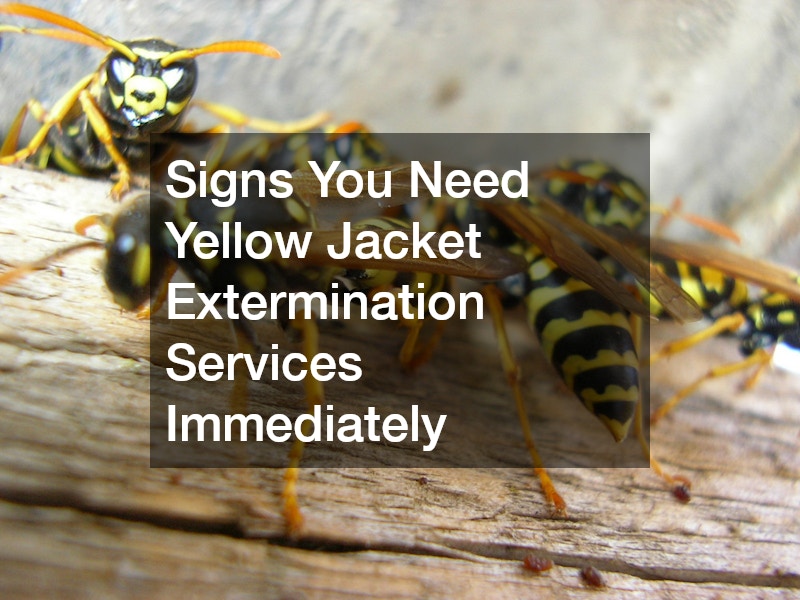Yellow jackets are more than just a nuisance; they’re a potential danger lurking in your backyard or garden. Timely extermination services can prevent unwanted encounters, ensuring safety for you and your loved ones.
These aggressive wasps are infamous for their painful stings and are capable of swarming their targets with relentless aggression. Understanding the signs of an infestation can prepare you to act quickly and reduce health risks.
Swift response is crucial, especially if you or someone in your household is allergic to stings. Taking preventive action not only mitigates danger but also helps maintain the tranquility of your home environment.
How Do I Identify a Yellow Jacket Infestation?
Visual Identification of Yellow Jackets
Yellow jackets can be distinguished from other insects by their sleek, hairless bodies and distinct black and yellow coloring. Unlike bees, their appearance is smooth and compact, lacking the furry bodies that characterize other similar insects.
These wasps typically measure about half an inch in length, equipped with a narrow waist that separates their thorax from their abdomen. Their wings are long and transparent, enabling them to fly rapidly and hover while exploring potential nest sites.
Yellow jackets are often confused with honeybees, yet their behavior is much more aggressive, particularly when a nest is disturbed. Understanding these physical traits is crucial for identifying and addressing potential infestations effectively.
Common Habitats and Nesting Sites
Yellow jackets tend to build their nests in concealed locations such as underground burrows, wall voids, or eaves. These locations provide the insect with protection against predators and unfavorable climatic conditions.
Often, piles of debris or stacks of firewood near homes can serve as inviting nesting sites. These places facilitate undisturbed growth, making infestations harder to detect.
Observing increased wasp traffic around such areas might indicate an undetected nest. Early detection helps in managing and addressing the problem before it escalates into a full-scale infestation.
What Are the Dangers of a Yellow Jacket Infestation?
Health Risks to Humans
Yellow jackets pose significant health risks, particularly to individuals allergic to insect stings. A single sting can cause severe reactions, including difficulty breathing, swelling, and even anaphylaxis.
The aggressive nature of these wasps means they can sting multiple times during an attack, unlike honeybees. This ability to sting multiple times increases the potential for serious injury or allergic reaction.
Given these dangers, encountering a large swarm can be particularly hazardous, requiring immediate and professional intervention to prevent life-threatening situations.
Impact on Pets and Livestock
Yellow jackets don’t solely pose a threat to humans; they can also endanger household pets and livestock. Animals may inadvertently provoke nests, leading to swarming and multiple stings.
The resulting pain and allergic reactions in pets can lead to distress and potential health emergencies. For livestock, such encounters are stressful and can impact productivity and well-being.
Prompt identification and management of nests are essential to safeguard both pets and animals from painful and harmful encounters with these aggressive insects.
When Should I Call for Professional Extermination Services?
Signs of an Established Infestation
Frequent sightings of yellow jackets around your property are a strong indication of an established infestation. Noticing several wasps near garbage bins, food sources, or water fixtures suggests the presence of a nearby nest.
A sudden increase in wasp activity, particularly later in summer or early fall, is a telltale sign that yellow jacket populations have grown significantly. Addressing this with professional help becomes more critical as the risks increase with colony size.
Other signs, like visible nest structures in eaves or ground burrows, further confirm their presence. Prompt extermination ensures control of the situation before it escalates, protecting your safety and property.
DIY Attempts and Their Limitations
Despite DIY pest control methods being readily available, yellow jacket infestations often prove too challenging for untrained individuals. Store-bought sprays might kill some wasps, but rarely eliminate an entire nest.
Attempting to destroy a nest yourself can provoke an aggressive response from the resident wasps, escalating the danger to you and bystanders. Professional services come equipped with specialized tools and protective gear to handle nests safely and effectively.
The expertise of professional yellow jacket extermination services ensures comprehensive control over the infestation, preventing further risks associated with inadequate DIY attempts. Investing in skilled services is wise when dealing with these persistent pests.
Addressing yellow jacket infestations swiftly and effectively is essential for maintaining a safe environment for you and your household. By recognizing the signs of infestation and understanding the associated dangers, you can take proactive measures.
Yellow jackets are not just a nuisance; they can pose real threats to humans, pets, and livestock. Professional services are vital for mitigating these risks and ensuring peace of mind.
Ultimately, it’s about safety, effectiveness, and ensuring that intrusive and dangerous pests are kept from disrupting your life. Don’t wait for the problem to grow beyond control—engage professional extermination services at the earliest sign of infestation.




